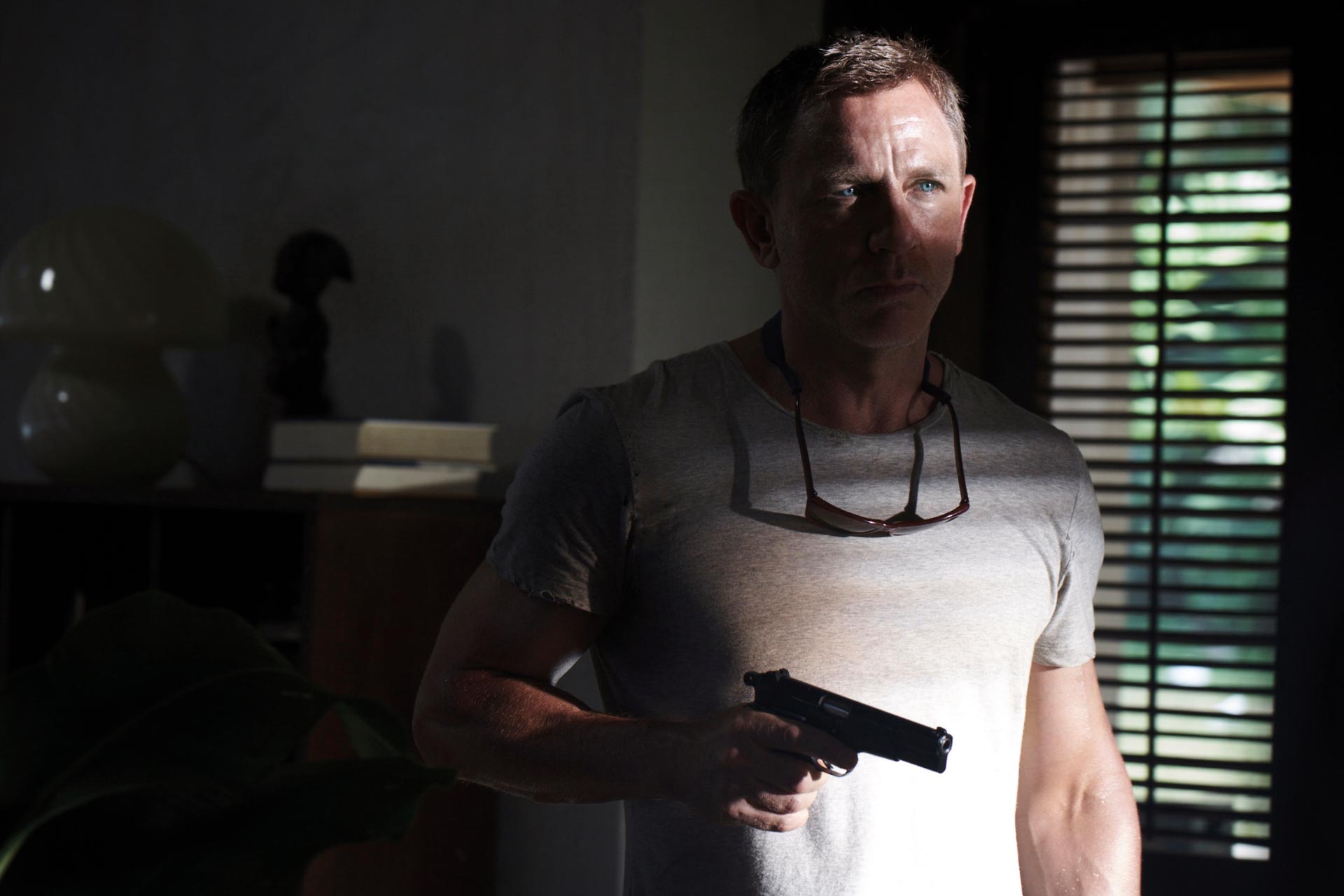When you want to add texture to a frozen lake, or cover the tracks of a fishtailing DB5, the man to speak to is No Time To Die Visual Effects Supervisor Charlie Noble. No stranger to the world of 007, Charlie worked on GoldenEye before returning to work on Bond 25 and has a CV littered with VXF standout movies including The Mummy, Batman Begins, Captain America: The First Avenger, Mission: Impossible – Fallout and Jason Bourne. We caught up with Charlie to find out more about the invisible effects he created for Bond’s 25th screen adventure …
(This interview contains No Time To Die plot spoilers)
What is the role of your team on a Bond film?
The work we do and the invisible effects we create are all about supporting the other departments. I see visual effects as an extension to all the other departments really. We had some amazing locations to work on from Ben Piltz. Lee Morrison’s team did some brilliant stunts and Chris Corbould produced some of his usual ingenious special effects. So we are standing on the shoulders of some pretty big giants there. We get called in when things can’t always be done for real – and then we make the impossible possible. We couldn’t really blow up an entire island or a building in London at dusk, so it’s better to do it within the computer. We enhance practical effects, smooth out some of the changeable lighting conditions when we’re shooting exterior work, and create set extensions to continue the fantastic work of Mark Tildesley.
What is the scope of VFX in No Time To Die?
It starts with choosing anything that’s not practical in camera, for whatever reason. They can be tiny, little things or they can be really big things. You’re dealing with the practicalities of everyday filmmaking – sometimes you might have some lights in shot or a camera track, so we have to paint them out: that’s the bread and butter for us. The easy stuff all the way up to how to sink a boat or blow up an island – things that you probably wouldn’t easily be able to do for real. So it varies but on this film, we had around 1,500 shots scattered throughout the movie. I would say that we touched – to varying degrees – and were involved with, close to one in every three shots across the film. Everything from laser beams on rifles through to bubbles in the water for the trawler scene.
What are the challenges then working on location?
Knowing that you’re only there for a limited amount of time to capture as much of the environment as possible – just in case anything crops up later – for those moments that are unforeseen so that we can recreate things if we have to. That’s the main part of our work. You’re there to make sure that everything shot is how we like it, but if there are visual effects set-ups to do, we need to be comfortable that what we’re shooting is achievable later on. It’s great to go to these fantastic places because the richness does come through and you can’t really replicate that. Shooting outside does throw out the usual challenges of changeable light and changeable weather conditions.
Can you share a scene where this happened?
I think a good example of that was the opening Norway sequence. We travelled to an amazing remote frozen lake just to the east of Oslo in Norway. Cary’s vision as director was for this house by the lake. The lake would be covered in this thick ice – the Norwegians call it steel ice. He wanted it to be an early morning, misty look. Cary and Linus, our cinematographer, selected one hero shot which had the perfect balance of this beautiful slightly pinky, early morning sky with a lovely layer of SFX mist. We built this CG version of the environment and we could then line up all the other angles that had been shot practically and use this as a guide as to how to grade the footage so that everything matched. We then also stripped in our CG ice. We tried to clear a large portion of the lake with the ice rink polishing machine but it never really cut through the top crusty layer of mushy frozen crystals and it didn’t really give us the deep, steel ice that we wanted to show so we had to strip ours in for all the shots running out onto the ice, which looks gorgeous actually. We are only adding in as much as is necessary. It was all shot with IMAX cameras and it looked pretty stunning on screen.
What were some of the other complex elements on No Time To Die?
There were a number of complicated setups. In terms of the number of locations that we knitted together, it would be the Norway safe house escape scene. That involved eight different locations being knitted together. Bond arriving in Norway was filmed in Norway and Pinewood; various locations for the car chase were between Norway, Scotland and Salisbury Plain. So each time we’re switching locations, we’re having to strip the backgrounds from one location into the incoming shot, just to keep continuity going. In the car chase, a lot of it was shot practically but every now and again we needed to push cars closer together so that certain action beats were more telegraphed. That sort of sequence is primarily driven by Lee and Chris but it’s a good example of how we’re all working in tandem. Every now and again we as VFX get involved to support the narrative.
You said earlier you couldn’t blow up a building for real, so what did your team do for the London lab scenes?
We see the tower block exploding from the exterior. It was toned down a bit from its original idea of the building fully exploding just to show that it’s a targeted attack on the lab. The villains weren’t necessarily wanting to blow the whole place up, just one area. We shot various plates in Canada Square in Canary Wharf for this sequence and we did aerial work as well. We gave it nice street lighting, tweaked the sky and made it look pretty to give us that lovely mirror effect that Cary was after as the whole city was reflected in the side of this building. It did look gorgeous. We did subtle work in that scene like adding and enhancing the laser beams of the sights on the rifles.
Which are your favourite effects that viewers might miss on a first watch?
I think the Norway ice work was gorgeous. That and the river chase, that was pretty special as well. Matera was fun too. There’s a lot of subtle stuff in there – we come out of a CG tunnel to reveal the whole of Matera. Whenever we have material of Matera, we’re putting the bridge in from a neighbouring town. We cleaned up a lot of 21st century clutter that was in shot – aerials, satellite dishes, cranes and anything that made it not look as quite as pretty as it really was. Then there’s the chase scene in the DB5 and we had to paint elements of those scenes out like tyre marks from previous takes. Once you get into what we call ‘The Donut Square’, Chris Corbould had rigged it with pyro that he clad onto this 1,000 year old square. We obviously couldn’t damage it but when the DB5 performed the donut move, the pyro went off, the bullet hits went off on the masonry as the car went around in a circle. Bond deploys the smoke as he exits and we needed to add a bit more just to give it that continuous donut look that the team was after. A nice cylinder of smoke as the DB5 exits the square.
Did the party scene in Cuba require VFX work?
Yes, we added to the look of the prosthetic make-up for the boils appearing on the faces when the iridescent mist containing Heracles comes down on the SPECTRE agents. We had to enhance a few of those to make the boils grow, certainly on a close up on one of the first guys to go down. The other thing we did was give a lovely sort of rainbow iridescent quality to the mist as it falls.
Were your team heavily involved with the trawler scene in Jamaica?
Absolutely. We filmed the real trawler in Jamaica and we had our scanning and texturing crew with us throughout so we could build a CG version of it for later use. Chris Corbould set an explosion off on the real thing so the shot of the plane flying away was created for real. We added a few extra bits and pieces that skid across the top of the water and we cleaned it up and got rid of the island in the shot but, pretty much, it was all in camera. It was a real explosion but we added a bunch of detritus and extra splashes. We added some more CG bubbles in there as well just to give it a bit more frenetic activity.

